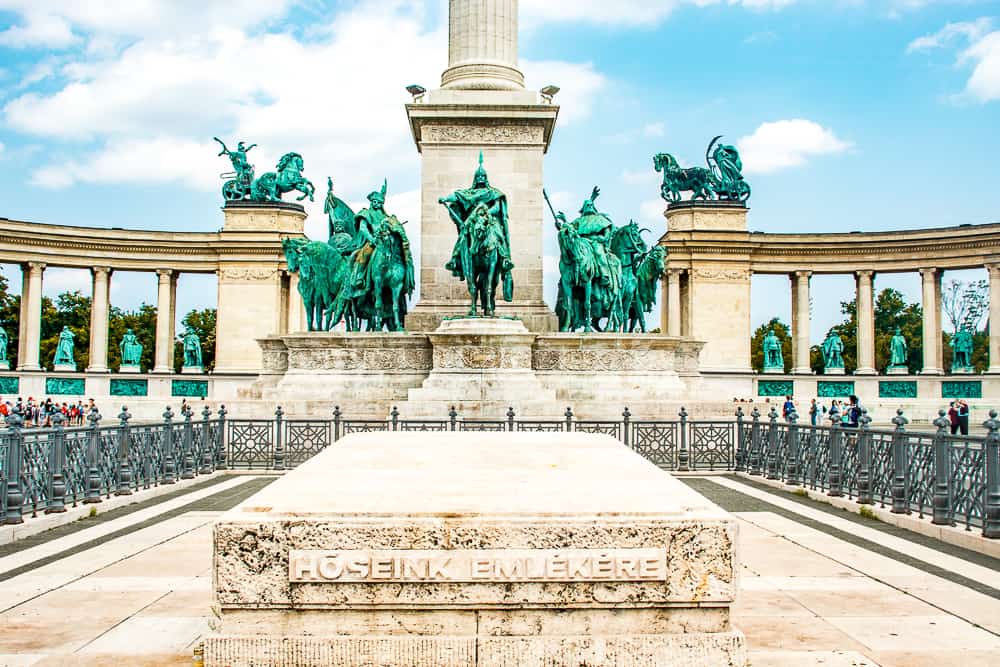Between the 1890s and the 1910s huge investments made Budapest a modern metropolis.
Heroes’ Square, this majestic gateway to City Park was erected in 1896.
The first metro of continental Europe was built also that time and it is still in use. Several market halls were built, such as the Great Market Hall and the Hungarian Parliament building was founded also at that time. The restoration and redesign of Matthias Church and the construction of Fisherman’s Bastion are also examples of the huge developments of the 1890s.
Heroes’ Square played the main role of the Millennial Celebrations. It commemorates the 1000-year anniversary of the arriving and settling down of the nomadic Magyar tribes in the Carpathian Basin.
The monument is a physical representation of Hungarian history.
In the center, the 7 original tribal leaders are shown on horseback.
The 36-meter-tall column in the middle of the square that is impressive even from a distance, has a figure of Archangel Gabriel, presenting the crown to the founding king.
The huge semicircular colonnade shows 14 statues of men who had major impacts on Hungary’s history.
Let’s take a look at these sculptures with some information and translations of the text inscribed below them.

Surrounding the central column, the chieftains are shown on horseback, wearing their medieval armour.
They were the tribal leaders who led the Magyars to the Carpathian Basin around A.D. 896.
Statues of the left colonnade of Heroes' Square
Couple of Labor and Wealth

Statue of War

SZENT ISTVÁN/STEPHEN I

Our nation’s founder, the first King of Hungary. He led Hungary to Christianity after defeating his pagan uncle Koppány in a battle for the nation’s spiritual future.
SZENT LÁSZLÓ/SAINT LADISLAUS

Ladislaus fought Turkic invaders in Transylvania.
There were multiple civil wars in the early years of his realm, before a period of widespread expansion. Several miracles are attributed to him, and he was canonized about a century after his death in 1095.
KÖNYVES KÁLMÁN/COLOMAN THE LEARNED

Colomon was a highly educated for that time.
He is best known for his proclamation that vampires and witches do not exist, saving many persecuted people from being burnt alive.
II ANDRÁS/ANDREW II

Andrew II fought wars during his reign. He led more than a dozen failed campaigns to expand his territory.
He also led a crusade into the heart of the Holy Land. After his return to Hungary, he needed to raise taxes because of the massive debt caused by his military adventure. His vassals rose up against him, demanding a guarantee to their privileges. It was the “Golden Bull of 1222” and it led to the rise of the aristocracy.
IV BÉLA/BÉLA IV

Béla IV inherited a weak nation from Andrew II and soon after his coronation, the Mongols invaded Hungary. The country was in tatters. Béla started the reconstruction and also prepared for subsequent attacks by building fortifications, forging alliances with neighboring countries.
KÁROLY RÓBERT/CHARLES I

Most nobles did not acknowledge his reign, Charles was forced to withdraw to the southern region of Hungary. Hungary dissolved into 12 provinces led by their own oligarchs. Charles had to fight for one dominion after another to reclaim the lands into his own realm.
By 1321 he dominated the entire country, establishing the reunited Hungary.
NAGY LAJOS/LOUIS I

Louis the Great inherited a centralized kingdom from his father, Charles I. He became one of the most powerful leaders of Hungary of all time. He expanded the influence of Hungary to the east and west.
Statues of the right colonnade of Heroes' Square
HUNYADI JÁNOS/JOHN HUNYADI

Hunyadi fought against the Ottoman Empire when it tried to expand towards Europe. He was soon charged with defending the southern borders and in 1456 Hunyadi defended Belgrade. Unfortunately, he died just 3 weeks after this victory, but the Turks did not try to attack Hungary for six decades.
MÁTYÁS/MATTHIAS CORVINUS

King Matthias was the son of John Hunyadi. During his three-decade reign, he patrolled art and science, brought Renaissance to Hungary while also initiated major building projects, created the famous royal library.
BOCSKAI ISTVÁN/STEPHEN BOCSKAI

After Hungary fell to the Ottomans in 1526, it became a battlefield between the Turks and the Habsburg Empire.
Bocskai led an army against the Ottomans but when the Habsburgs imposed forced control over Transylvania, he protested against the Austrian rule. With wide support, he led his armies against the Habsburg troops. He was elected to be the Prince of Transylvania in 1605 and negotiated peace treaties with both the Turks and the Habsburgs.
BETHLEN GÁBOR/GABRIEL BETHLEN

Bethlen supported Bocskai and his successor Gábor Báthory, but later Bethlen fell out with the new leader and took refuge with the Ottomans. The Turks provided Bethlen with an army to return home and drive Báthory out of power.
He became the Prince of Transylvania and also King-elect of Hungary from 1620 to 1621, but he never took control of the whole kingdom. Bethlen, supported by the Ottomans, led his Calvinist principality against the Habsburgs and their Catholic allies.
He conquered most of Habsburg-held northern Hungary and seize the Crown of St. Stephen. Later Bethlen agreed to return the crown in exchange for a Habsburg treaty securing Hungarian civil rights.
Bethlen then made efforts to expel the Turks from Hungary but died before this could be achieved.
THÖKÖLY IMRE/COUNT IMRE THÖKÖLY

The father of Thököly, a noble from northern-Hungary opposed the Austrians. After his death, Thököly had to flee to Transylvania, where he met anti-Habsburg refugees. Together they allied against Austrian rule. With Ottoman support, they won several battles and the Turks declared him as Prince of Upper Hungary in 1682. After the Turks lost the Battle of Vienna just a year later and Thököly went to exile in Constantinople.
II RÁKÓCZI FERENC/FRANCIS II RÁKÓCZI

Rákóczi carried on the fight for freedom against the Habsburgs. Ha forged an alliance with King Louis XIV of France to launch a revolution in 1703 with a peasant army led by Tamás Esze.
After the early success, Rákóczi was declared Prince of Transylvania but the French could not assist his troops longer and Rákóczi had to flee. He lived in Turkey until his death.
KOSSUTH LAJOS/LOUIS KOSSUTH

Hungary’s oppression by Austria continued into the 19th century.
Kossuth demanded a parliamentary government for Hungary in March 1848.
He was widely supported by Hungarians. He became the leader of the 1848-49 revolution.
After several victories of the rebels, the Habsburgs asked for the help of the Russians. The Russians arrived with an enormous troop of 200,000 soldiers. No bigger troop was fighting outside Russia – not even during the Napoleonic Wars. The revolution had no chance after this.
Attractions near Heroes’ Square
How to get to Heroes’s Square
Take M1 Millennium Underground from any of its station in downtown Pest and get off at Heroes’ Square station.
If you liked this post please share it with your friends using these buttons or pin the image below:

Related posts


